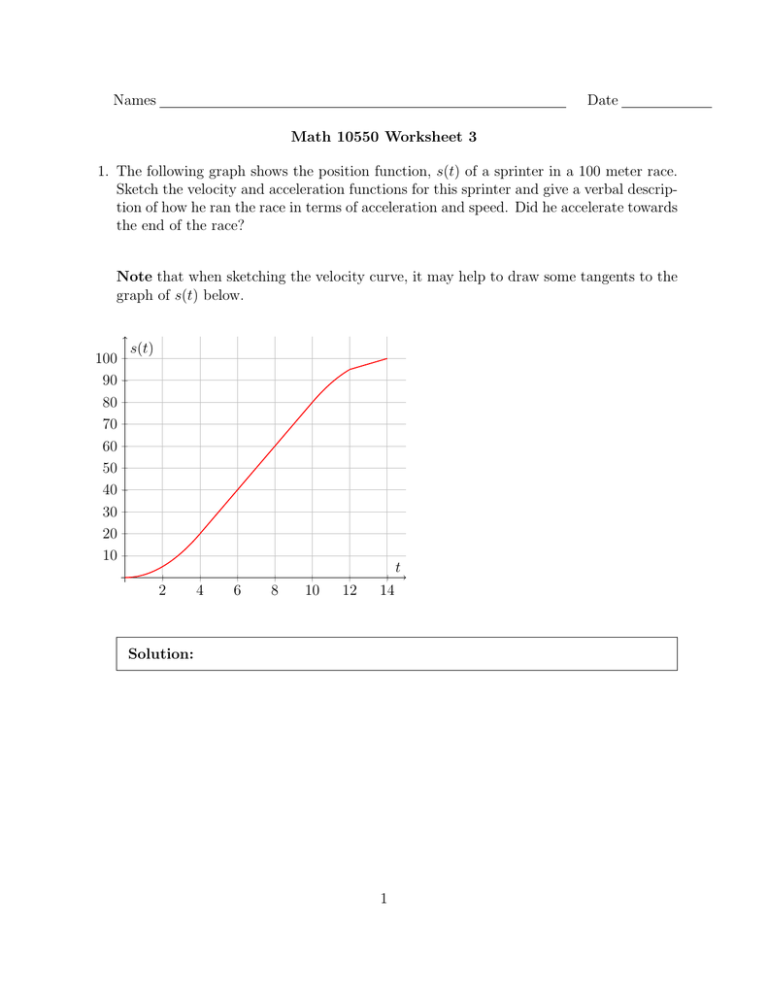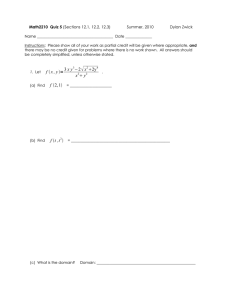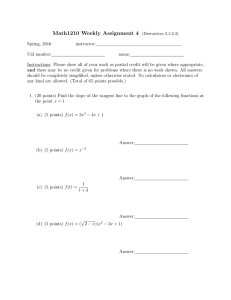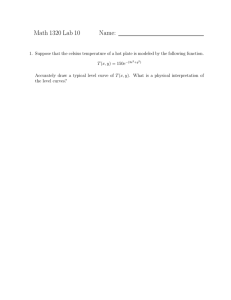Names Date Math 10550 Worksheet 3 1. The following graph shows
advertisement

Names Date Math 10550 Worksheet 3 1. The following graph shows the position function, s(t) of a sprinter in a 100 meter race. Sketch the velocity and acceleration functions for this sprinter and give a verbal description of how he ran the race in terms of acceleration and speed. Did he accelerate towards the end of the race? Note that when sketching the velocity curve, it may help to draw some tangents to the graph of s(t) below. 100 90 80 70 60 50 40 30 20 10 s(t) t 2 4 6 8 10 12 14 Solution: 1 11 s0 (t) 10 9 8 7 6 5 4 3 2 1 t 2 4 6 8 10 12 14 00 3 s (t) 2 1 t 2 4 6 8 10 12 14 −1 −2 −3 The sprinter begins by accelerating, then at around 4 seconds, he stops accelerating and starts running at a constant speed. At 10 seconds, he starts slowing down (negative acceleration), and then starts running at a (slower) constant speed again at 12 seconds. In the last few seconds of the race the position graph has constant slope, which means that the velocity is constant. Thus the acceleration is 0. 2 2. (Practice for Partial Credit questions on Exam 1 and exercise in writing mathematics). Use the limit definition of the derivative to find f 0 (x) where f (x) = 1 . 3x+2 Find the mistake in the following solution and give the complete correct solution in the space below: f (x + h) − f (x) h→0 h 1 1 − 3x+2 3(x+h)+2 = lim h→0 h 1 1 − 3x+2 3x+3h+2 = lim h→0 h f 0 (x) = lim = lim 3x+2−3x+3h+2 (3x+3h+2)(3x+2) h 4 + 3h = lim h→0 (3x + 3h + 2)(3x + 2)h As h → 0, the numerator approaches 4 and the denominator approaches 0. So the quotient approaches +∞ as h → 0+ and it approaches −∞ as h → 0− . therefore f 0 (x) does not exist for any value of x. h→0 Solution: The error is in the fourth line, where the numerator is incorrect because of a failure to distribute the negative sign. The numerator should be 3x+2−(3x+3h+2). The correct solution is as follows. f (x + h) − f (x) h→0 h 1 1 − 3x+2 3(x+h)+2 = lim h→0 h 1 1 − 3x+2 3x+3h+2 = lim h→0 h 3x + 2 − (3x + 3h + 2) = lim h→0 (3x + 3h + 2)(3x + 2)h −3h = lim h→0 (3x + 3h + 2)(3x + 2)h −3 = lim h→0 (3x + 3h + 2)(3x + 2) −3 = (3x + 2)2 f 0 (x) = lim 3 3. You are designing a roller coaster and specifying equations for the different pieces so that you can print the model on your 3D printer. In Cartesian coordinates, the equations for the pieces give a piecewise defined function. Two adjoining pieces of the roller coaster model correspond to the piecewise defined function shown below: 2 cx + c + 2 −5 ≤ x ≤ 1 f (x) = 2x + 2c 1<x<3 What value must you choose for c in order to make the transition between these two pieces perfectly smooth? Solution: First, let’s see what choice of c can make the function continuous. We consider the point where the pieces meet, at x = 1. The two functions must be equal there, so we get c(1)2 + c + 2 = 2(1) + 2c and simplifying we obtain 2c + 2 = 2c + 2, which is true for all values of c. Now let’s get the derivatives to match up so that the function will have a continuous derivative. Taking the derivative of both functions and setting them equal, we get 2cx = 2. Evaluating at x = 1 leads us to conclude that we must have c = 1. 3x2 + 1 , or equivalently use x2 − x + 1 the product rule to find f 0 (x) where f (x) = (3x2 + 1)(x2 − x + 1)−1 . 4. (a) Use the quotient rule to find f 0 (x) where f (x) = 4 Solution: (3x2 + 1)0 (x2 − x + 1) − (3x2 + 1)(x2 − x + 1)0 (x2 − x + 1)2 (6x)(x2 − x + 1) − (3x2 + 1)(2x − 1) = (x2 − x + 1)2 6x3 − 6x2 + 6x − (6x3 − 3x2 + 2x − 1) = (x2 − x + 1)2 2 −3x + 4x + 1 = (x2 − x + 1)2 f 0 (x) = 5 (b) Find the equation of the tangent line to the curve y = (x3 − 2x + 4)(x5 − x + 1) at x = 1. Solution: We find the slope of the tangent line by using the product rule. m(x) = (x3 − 2x + 4)0 (x5 − x + 1) + (x3 − 2x + 4)(x5 − x + 1)0 = (3x2 − 2)(x5 − x + 1) + (x3 − 2x + 4)(5x4 − 1). Evaluating at x = 1 gives us m = (3(1) − 2)((1) − 1 + 1) + (1 − 2 + 4)(5 − 1) = (1)(1) + (3)(4) = 13. The y value of the curve at x = 1 is (1 − 2 + 4)(1 − 1 + 1) = 3. Therefore we need a line with slope 13 going through the point (1, 3). An equation for this line is y − 3 = 13(x − 1) or equivalently y = 13x − 10 √ (c) Find g 0 (x), g 00 (x) and g 000 (x) when g(x) = 6 3 x + x3 + 4x2 + 2x + 1. 6 Solution: 2 6 + 3x2 + 8x + 2 g 0 (x) = 6x− 3 + 3x2 + 8x + 2 = √ 3 2 x 5 −4 g 00 (x) = −4x− 3 + 6x + 8 = √ + 6x + 8 3 x5 20 8 20 g 000 (x) = x− 3 + 6 = √ + 6. 3 3 3 x8 (d) If h(2) = 2, h0 (2) = 1/3, k(2) = 6, k 0 (2) = −1, find k 0 h (2). Solution: In general, using the quotient rule we get 0 h(x)k 0 (x) − k(x)h0 (x) k(x) . = h(x) h(x)2 At the point x = 2 we obtain, 0 k(2) (2)(−1) − (6)(1/3) −2 − 2 h(2)k 0 (2) − k(2)h0 (2) .= = = −1. = 2 2 h(2) h(2) 2 4 7 5. Water is poured at a constant rate into the vase in the figure shown below. Let h(t) denote the height of the water in the vase at time t (assume the vase is empty at time t = 0). Sketch a rough graph of h(t) and h0 (t). Solution: 8 6. (Optional, Practice for exam) A car is traveling at night along a road shaped like a parabola. Using a Cartesian co-ordinate system superimposed on the map, the equation of the road (locally) is y = x2 + 1. The car starts at the point (4, 17) and moves along the road in a direction so that its x-coordinate is decreasing. A sign is located at the point (1, 0). Assuming that nothing is blocking the path of the light from the headlights to the sign, give the co-ordinates of the position of the car when the headlights hit the sign. A picture may help you to solve this problem. Solution: y 15 10 car 5 x −4 −3 −2 −1 1 2 3 4 We want to find a point x0 so that the tangent line to y = x2 + 1 at x = x0 passes through the point (1, 0). This means that the headlights (which shine in a line tangent to the curve along which the car is driving) hit the point at which the sign is located. First of all, we can find the slope of the curve at x0 . It is y 0 (x0 ) = 2x0 . Thus, we know that we want a line which passes through (1, 0) and (x0 , x20 + 1) having slope m = 2x0 . We can use the point-slope form of the equation of a line to solve for the unknown x0 . 0 − (x20 + 1) = 2x0 1 − x0 −x20 − 1 = 2x0 − 2x20 x20 − 2x0 − 1 = 0 9 Solving the quadratic for x0 yields x0 = 1 ± √ 2 The lights of the car will first hit the sign √ when the car is going toward the sign, so we√choose √ the positive root x0 = 1 + 2. Thus the point we are seeking is (1 + 2, 4 + 2 2). 10



